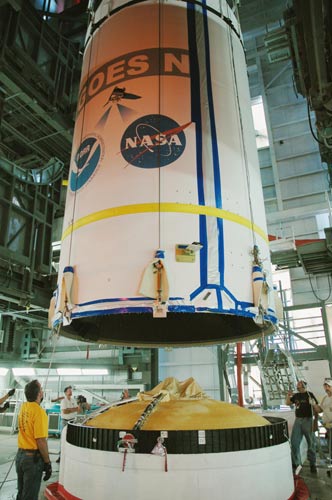After Long Delay, New Weather Satellite Again Set to Fly

The firstof an advanced batch of Earth-watching satellites is poised to rocket spacewardWednesday after a year of delays that have plagued its weather forecastingmission.
A Boeing Delta4 rocket is set to launch the GOES-N satellite - one of a three newspacecraft aimed at monitoring changes in Earth's weather and environment -from Florida's Cape Canaveral Air Force Station at 6:11 p.m. EDT (2011 GMT). Technicalproblems - including a last-minute launchscrub - and Boeing's worker strikelast year have delayed the mission from its initial May 2005 target.
"It's beena long, challenging effort," said Andre Dress, NASA's GOES deputy programmanager at Goddard Space Flight Center, Tuesday duringa prelaunch briefing. "This satellite does represent the latest in satellitetechnology and promises to improve performance over its predecessor."
The $481-millionGOES-N - short for Geostationary Operational Environmental Satellite-N -spacecraft will carry extremely precise imaging and sounding instruments capableof resolving storm features down to 1.2 miles (two kilometers) from itsgeosynchronous perch 22,000 miles (35,405 kilometers) above Earth.
Weathersatellites are a key asset for forecasters, especially as the 2006 AtlanticBasin hurricane season - which begins June 1 - approaches, said Steve Letro, the meteorologist-in-charge for the NationalWeather Service's forecast office in Jacksonville, Florida.
"There is verylittle in our arsenal which allows us to gather data from the entire oceanbasin around a storm," Letro said, adding that only satellites can provide thosenecessary weather pattern observations on an hourly basis or faster.
In additionto its Earth-watching instruments, GOES-N carries a Solar X-ray Imager andSpace Environment Monitor to track space weather and Sun activity. Thesatellite can also serve as an emergency relay by using a search and rescuetransponder to bounce distress signals from their origin to recovery crews,mission managers said.
Breaking space news, the latest updates on rocket launches, skywatching events and more!
GOES-N's missionwill add a second spare satellite to aid the weather forecasting efforts of theNational Oceanic and Atmospheric Administration (NOAA). NOAA is working withNASA on the planned spaceflight, which has a 60 percent chance of launchingduring its one-hour window on Wednesday, mission weather officials said.
NOAA currentlyoperates GOES-10 and GOES11 to track daily weather and severe storms, such as hurricanes andtornadoes, with another satellite - GOES-12- in a storage orbit. Mission managers plan to rename GOES-N as the observationsystem's 13th satellite once final post-launch checks are complete,then place it into a storage orbit until GOES-10 is retired.
"We havebeen storing satellites on orbit since 1997," NOAA's GOES program manager SteveKirkner told reporters during the briefing, adding that orbital storage cansave more than $3 million in ground storage costs.
NOAA plansto launch two followers - GOES-O and GOES-P - to fly in GOES-N's wake. Kirkner saidGOES-O is currently targeted for an April 2008 launch to be followed in October2009 by GOES-P.
NASA willbroadcast the GOES-N launch live on NASATV beginning at 6:00 p.m. EDT (2000 GMT) on Wednesday. You are invited tofollow along with the planned space shot using SPACE.com's NASA TV feedby clicking here.
- For Boeing, Next Delta 4 Rocket Launch Carries More Than a Satellite
- Boeing's Union Strike Delays Satellite Launch Plans
- Scrub Delays Delta 4 Launch Until October
- Countdown Coverage for GOES-N's First Launch Attempt

Tariq is the award-winning Editor-in-Chief of Space.com and joined the team in 2001. He covers human spaceflight, as well as skywatching and entertainment. He became Space.com's Editor-in-Chief in 2019. Before joining Space.com, Tariq was a staff reporter for The Los Angeles Times covering education and city beats in La Habra, Fullerton and Huntington Beach. He's a recipient of the 2022 Harry Kolcum Award for excellence in space reporting and the 2025 Space Pioneer Award from the National Space Society. He is an Eagle Scout and Space Camp alum with journalism degrees from the USC and NYU. You can find Tariq at Space.com and as the co-host to the This Week In Space podcast on the TWiT network. To see his latest project, you can follow Tariq on Twitter @tariqjmalik.
